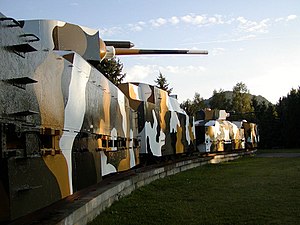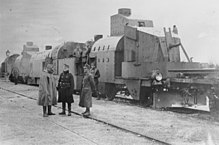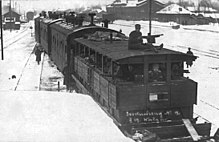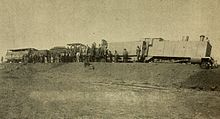Armoured train
This article needs additional citations for verification. (October 2019) |

An armoured train (
Armoured trains were historically fighting systems, equipped with heavy weapons such as artillery. An exception was the US "White Train", the Department of Energy Nuclear Weapons Transport Train, armoured and escorted by personnel armed with personal weapons.[4]
Definition
An armoured train is characterized by the armour from which it takes its name.
It is not to be confused with Railroad artillery, which includes a large-caliber gun and its crew, but without special protection from them. Trains simply equipped with light weapons without elaborate protective devices, e. g. a simple wagon with a few machine guns sheltered behind sandbags, are also not considered to be armoured trains.[5]
Design and equipment


The rail cars on an armoured train were designed for many tasks. Typical roles included:
- railway guns.
- Infantry – designed to carry infantry units, may also mount machine guns.
- Machine gun – equipped with machine guns.
- Anti-aircraft– equipped with anti-aircraft weapons.
- Command – similar to infantry wagons, but designed to be a train command centre
- Anti-tank – equipped with anti-tank guns, usually in a tank gun turret
- Platform – unarmoured, used for any purpose from the transport of ammunition or vehicles, through track repair or derailing protection, to railroad ploughs for track destruction.
- Troop sleepers
- The German away from the railway line
- first strike succeeding in destroying the launchers for a retaliatory strike). The US at one time proposed having a railway-based system for the MX Missile program, but this never got past the planning stage. The US also used an armoured Department of Energy Nuclear Weapons Transport Train, not for fighting but for transport within the country
Different types of armour were used to protect from attack by tanks. In addition to various metal plates, concrete and sandbags were used in some cases for improvised armoured trains.
Armoured trains were sometimes escorted by a kind of rail-tank called a
History
Origins
Armoured and armed trains saw use during the 19th century in the American Civil War (1861–1865), the Franco-Prussian War (1870–1871), the First and Second Boer Wars (1880–1881 and 1899–1902). During the Second Boer War Winston Churchill, then a war correspondent, was travelling on an armoured train which was ambushed by a Boer commando led by General Louis Botha on 15 November 1899; the Boers captured Churchill and many of the train's contingent.[5]
Early in the 20th century, Russia used armoured trains during the
American Civil War
The most successful armed train was a single armoured wagon built to defend the Philadelphia, Wilmington and Baltimore Railroad. The railroad had been attacked by southern forces to prevent transport of Union soldiers to the front, and snipers were discouraging men attempting to repair the damage. Baldwin Locomotive Works modified a baggage wagon in late April 1861. A 24-pounder howitzer was placed on a swivel mount at the opposite end of the wagon from the pushing locomotive. The sides of the wagon were sheathed with 2.5-inch (6.4 cm) oak planks covered with 0.5-inch (1.3 cm) boiler plate. The end of the wagon around the howitzer was fitted with hinged 2-foot (61 cm) panels which could be temporarily lifted to aim and fire the howitzer and then lowered to protect the crew of six men loading the howitzer with canister shot or grapeshot. The remainder of the wagon contained fifty ports for riflemen. The wagon was effective for its original purpose, but vulnerability to artillery rendered such wagons of comparatively little use during later stages of the war. In August 1864, a Confederate raiding party disabled a Baltimore and Ohio Railroad locomotive pushing an armoured wagon, and then piled ties around the armoured wagon and set them afire.[8]
Volunteers
In 1884 Charles Gervaise Boxall (1852–1914), a Brighton-born solicitor and officer in the 1st Sussex Artillery Volunteers, published The Armoured Train for Coast Defence in Great Britain, outlining a new way to employ heavy artillery. In 1894, when he had become commanding officer of the 1st Sussex AV, railway workers among the volunteers of No 6 Garrison Company manned an armoured train constructed in the workshops of the London, Brighton and South Coast Railway (of which the unit's Honorary Colonel, Sir Julian Goldsmid, was a director).[9][10][11]
Second Boer War
The
World War I


During World War I Russia used a mix of light and heavy armoured trains. The heavy trains mounted 4.2 inch or 6 inch guns; the light trains were equipped with 7.62 mm guns.[6]
A

Two armoured trains were constructed at Crewe Works during 1915 for British coastal defense duties; one was based in Norfolk and one in Edinburgh to patrol rail routes on stretches of coast considered vulnerable to amphibious assault. The trains comprised two gun trucks, one at each end, mounted with a 12-pounder quick firing gun and a machine gun; an armoured cabin behind the artillery piece contained the magazine. Inboard of each gun truck was a truck for infantry quarters. This was also armoured, with observation ports and loops for rifle fire. The armoured locomotive, with the cab and motion protected, was marshalled into the centre of the train. The driver took up a position at whichever end of the train was leading, with the regulator controlled by a mechanical connection. The intention was that the infantry, with artillery support from the train's guns, was to hold off a hostile landing force until reinforcements could be deployed.[17][18][19]
Italy fitted twelve armed trains (under the control of the
Two armoured trains were produced in the railway workshop located at
Interwar years

The Bolshevik forces in the Russian Civil War used a wide range of armoured trains, including Trotsky's one.[22] Many were improvised by locals, others were constructed by naval engineers at the Putilov and Izhorskiy factories.[22] As a result, the trains ranged from little more than sandbagged flatbeds to the heavily armed and armoured trains produced by the naval engineers.[22] An attempt to standardise the design from October 1919 only had limited success.[22] By the end of the war the Bolshevik forces had 103 armoured trains of all types.[22]
The
Estonia built a total of 13 armoured trains during the Estonian War of Independence: six on broad-gauge and seven on narrow-gauge railways. The first three armoured trains with fully volunteer crews formed the backbone of the front in critical early stages of conflict. Carriages were former goods carriages and at first armor was limited to wood and sand, but later steel plating, machine guns, and cannons were added.[24] Estonia later created a regiment for its armoured trains in 1934, called the Armoured Train Regiment, which consisted of 3 armoured trains.[25] The regiment was dissolved in 1940, after the USSR invaded the Baltic States, and its railway artillery cannons were transferred to the Soviet army.[26]

After the First World War the use of armoured trains declined. They were used in China in the twenties and early thirties during the Chinese Civil War,[28] most notably by the warlord Zhang Zongchang, who employed refugee Russians to man them.
World War II

Poland used armoured trains extensively during the invasion of Poland. One observer noted that "Poland had only few armoured trains, but their officers and soldiers were fighting well. Again and again they were emerging from a cover in thick forests, disturbing German lines".[29] One under-appreciated aspect of so many Polish armoured trains being deployed during the Polish Defensive War in 1939 is that when German planes attacked the railroads, it was usually the tracks themselves. As late as 17 September, three fresh divisions in the east were moved westward by train. On 18 September, three more divisions followed.[citation needed]
This in turn prompted Nazi Germany to reintroduce armoured trains into its own armies. Germany then used them to a small degree during World War II.[30] They introduced significant designs of a versatile and well-equipped nature, including railcars which housed anti-aircraft gun turrets, or designed to load and unload tanks and railcars which had complete armour protection with a large concealed gun/howitzer. Germany also had fully armoured locomotives which were used on such trains.[citation needed]


During the
The Red Army had a large number of armoured trains at the start of World War II but many were lost in 1941.[33] Trains built later in the war tended to be fitted with T-34 or KV series tank turrets.[33] Others were fitted as specialist anti-aircraft batteries.[33] A few were fitted as heavy artillery batteries often using guns taken from ships.[33]
Canada used an armoured train to patrol the
Twelve armoured trains were formed in Britain in 1940 as part of the preparations to face
The Imperial Japanese Army also utilized armored trains. First in the 1920s, to guard the rail lines in Manchuria and later when they engaged Chinese NRA and CPC troops in Second Sino-Japanese War (1937–1945).[38][39][40]
In 1940 Italy had twelve armed trains ready for use (again under
Post-World War II

In the
Fulgencio Batista's army operated an armoured train during the Cuban Revolution; it was derailed and destroyed during the Battle of Santa Clara, and is commemorated by the Tren Blindado (armoured train) memorial.
An improvised armoured train named the "
Soviet Union
Facing the threat of Chinese cross-border raids during the Sino-Soviet split, the USSR developed armoured trains in the early 1970s to protect the Trans-Siberian Railway. According to different accounts, four or five trains were built. Every train included ten main battle tanks, two light amphibious tanks, several AA guns, as well as several armoured personnel carriers, supply vehicles and equipment for railway repairs. They were all mounted on open platforms or in special rail cars. Different parts of the train were protected with 5–20 mm thick armour. These trains were used by the Soviet Army to intimidate nationalist paramilitary units in 1990 during the early stages of the First Nagorno-Karabakh War.[52][53]
Towards the end of the
Russia
Regular armoured trains have continued to be used by the post-Soviet Russian military. Two were deployed during the
An armoured train made up of two diesel locomotives powering eight various railcars, which carried anti-aircraft weaponry and unknown cargo supported the southern flank of the
Armoured tram
Armoured trams have also been used, although not purpose-built. The just-formed Red Army used at least one armoured tram during the fighting for Moscow in the October Revolution in 1917.[57][58][59] The Slovak National Uprising, better known for its armoured trains described above, also used at least one makeshift example.[60]
See also
References
- ^ a b Trevithick, Joseph (7 March 2022). "A Russian Armored Train Has Joined The Invasion Of Ukraine". The War Zone. The Drive.
- ^ a b Dangwal, Ashish (9 March 2022). "Russian 'Armored Train' Equipped With Automatic Cannons & Painted With 'Z' Mark Joins The Ukraine Invasion". EurAsian Times. Retrieved 10 March 2022.
- ^ a b "Russia has released video of an armoured train moving through Ukraine". Sky News. 23 June 2022.
- ^ "White Train". Amarillo Railroad Museum. Archived from the original on 22 June 2012. Retrieved 7 September 2022.
- ^ ISBN 978-1-84603-242-4.
- ^ ISBN 0-85368-606-8.
- ^ Mikhail Blinov. "Chinese Civil War Armies". Paris Guide - France in the old photos: famous sights, museums. Retrieved 14 July 2023.
- ^ "A Civil War Iron Clad Car". Railroad History. 130 (Spring 1974). The Railway & Locomotive Historical Society: 51–53. 1974.
- ISBN 0-9508205-0-4, pp. 160–2.
- ^ "Shoreham Fort - The 1st Sussex Artillery Volunteers". Shoreham Fort.
- ^ Boxall at Oxford Dictionary of National Biography
- ^ Gen Sir Aylmer Haldane, A Soldier's Saga, Edinburgh: William Blackwood, 1948, pp. 139–46.
- ISBN 0-330-23861-2, pp. 104–5.
- ISBN 0-297-83222-0, pp. 95–6.
- ^ Roy Jenkins, Churchill. A Biography, Farrar, Straus and Giroux, New York, 2001, p. 52.
- ISBN 0-14-011651-6
- OCLC 835846426.
- ^ Batchelor, Simon. "Armoured trains in the First World War". National Railway Museum. Retrieved 23 September 2019.
- ^ Nathan, Stuart (13 February 2017). "February 1919: First World War armoured trains". The Engineer.
- ^ Caiti, Pierangelo (1974). Artiglierie ferroviarie e treni blindati. Bologna: Ermanno Albertelli Editore. pp. 79–83.
- ^ Khan, Shoeb (25 July 2018). "Iraq: UK offers assistance in restoring railway workshop in Ajmer". The Times of India. Archived from the original on 6 June 2019. Retrieved 4 March 2022.
- ^ ISBN 0-85368-606-8.
- Dorling Kindersley, 2003, Page 251
- ^ Rosenthal, Reigo (28 September 2012). "Armoured trains in Estonian War of Independence". Estonica. Archived from the original on 5 February 2022. Retrieved 7 August 2018.
- ISBN 9985945549.
- ^ Allandi, Harri (2007). Tapal paiknenud soomusrongirügement sõnas ja pildis 1923–1940 (in Estonian). Tapa: Trükk Pakett AS.
- ISBN 978-609-412-089-3. Archived from the original(PDF) on 21 April 2017. Retrieved 5 August 2018.
- ^ "Armored Car Like Oil Tanker Used by Chinese" Popular Mechanics, March 1930
- ISBN 3-920722-69-8
- ISBN 978-3895551048
- ^ a b "Múzeum Slovenského národného povstania".
- ^ a b c "Foto a video: Pancierový vlak Štefánik dobojoval, skončí v Múzeu SNP". Bystricoviny.sk - správy - kultúra - šport (in Slovak). 1 September 2014. Retrieved 9 April 2020.
- ^ ISBN 0-85368-606-8.
- ISBN 978-1411639270(pp. 82-84)
- ^ Balfour, G 1981. The Armoured Train: its development and usage. Batsford
- ^ "The Tank Museum | E1987.159". tankmuseum.org.
- ^ "The Romney Hythe and Dymchurch Railway". narrow-gauge-pleasure.co.uk. Archived from the original on 26 September 2011. Retrieved 7 May 2011.
- ^ Taki's Imperial Japanese Army page: Improvised Armored Train
- ^ Taki's Imperial Japanese Army page: Special Armored Train
- ^ Taki's Imperial Japanese Army page: Type 94 Armored Train
- ^ Caiti, p. 84-9
- ^ Le 5e Régiment du Génie d'hier et d'aujourd'hui : l'aventure des Sapeurs de chemins de fer, Lavauzelle, 1997, p. 73 (in French)
- ^ L'audace du rail : les trains blindés du Sud-Annam in Revue historique des armées #234, Alexis Neviaski, 2004, quoted in the French Defense Ministry archives Archived 16 December 2008 at the Wayback Machine
- ^ French Defense Ministry archives ECPAD website Archived 30 September 2007 at the Wayback Machine
- ^ French Defense Ministry archives ECPAD website Archived 27 September 2007 at the Wayback Machine
- ^ French Defense Ministry archives ECPAD website Archived 27 September 2007 at the Wayback Machine
- ^ French Defense Ministry archives ECPAD website Archived 27 September 2007 at the Wayback Machine
- ^ a b "Krajina Express" enhances Serb Firepower near Bihac Deseret News, 4 December 1994
- ^ Radic, Aleksandar (2008). Историја - Крајина експрес. Арсенал magazine, nº 14, pp. 51-54. Minister of Defence of Serbia, 15 February 2008 (in Serbian)
- ^ "Panoramio is no longer available". www.panoramio.com. Archived from the original on 20 February 2018. Retrieved 5 December 2017.
- ^ Hrvatski oklopni voz (in Serbian)
- ISBN 5-7511-1819-7
- Cyrillic/Russian language) - Markovian, Victor; Мир оружия, 9/2005
- ^ tvzvezda.ru, Редакция. "Ополченцы соорудили бронепоезд для защиты от украинских силовиков". tvzvezda.ru.
- ^ Russian special armored train "Yenisei" (video). Ministry of Defense of the Russian Federation. 14 June 2022 – via Youtube.
- ^ "The Russians have developed an armored train "Yenisei" from diesel locomotives stolen in the Kharkiv region". newsreadonline. 28 June 2022. Archived from the original on 28 June 2022. Retrieved 8 August 2022.
- Dorling Kindersley, 2003, Page 231.
- ^ Московские трамваи в боях за Советскую власть (in Russian)
- ^ Мы мирные люди, но наш бронепоезд стоит на трамвайном пути! (in Russian)
- ISBN 1-85828-904-1, Page 482
Further reading
- Zaloga, Steven J; Bryan, Tony (2008). Armored Trains. Oxford, UK: Osprey Publishing. ISBN 978-1-84603-242-4.


